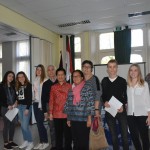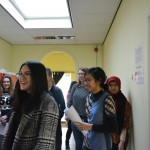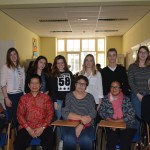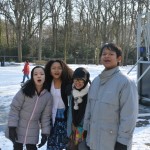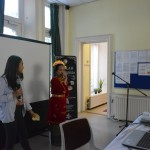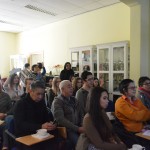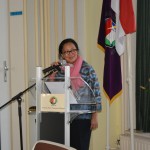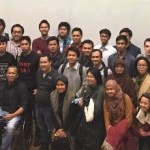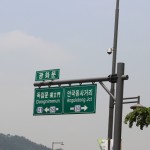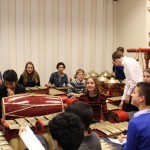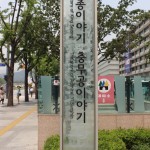 By Gunaryadi
By Gunaryadi
It was midsummer 2013 in the northern subtropics when I took an academic sojourn to the Republic of Korea (henceforth Korea). As the aeroplane was approaching the landing strip of the Incheon International Airport, I was a bit astonished when I looked through the window. The seasonal air-view resembled that of the Amsterdam Airport Schiphol I had left few days earlier. Both airports were built on reclaimed ground, encircled by waters, and are equally world’s class. A UK-based consultancy on airline and airport review and ranking, Skytrax, rated Incheon as the world’s best airport in 2012. However, in 2013 Schiphol surprisingly ascended to the third place, only a rank behind Incheon in the Skytrax’s list. After all, they differed slightly in few ways: Schiphol has greener surroundings; and it’s larger in term of total passengers (in 2012, roughly 51 million) while Incheon (approximately 39 million). Yet, when you’re in Incheon you would sense the futuristic impression, faster transits, brighter halls, and equipped with cutting-edge concourse for international passengers which is connected with efficient underground passageways furnished with smooth intra-airport transit vehicles to the main terminal.
At first glance, comparing airports in Asia and Europe as an illustration of modernity and relative weight of global leverage of countries contains a definite degree of subjectivity. That is true in perceptive sense since it is the airport that would generate the initial impression of foreigners on the respective country. But a more objective fact is that we have seen and used lots of Korean-branded products in Europe, from automobiles to electronics and information technology gadgets; and moreover in Asia and elsewhere from dramas to pop culture. That is what they call ‘hallyu’, the ‘Korean wave’ that has emerged since the late 1990s and has nearly irresistibly penetrated boundaries of nations. Joseph S. Nye (2009) dubbed ‘hallyu’ as ‘the growing popularity of all things Korean …’
Viewing Korea and Netherlands using comparative binoculars will surely reveal certain extent of difference and similarities. In some aspects the resemblance and discrepancy are wide; while in some ways they are narrow.
In geographical term, both are located in the northern hemisphere although Netherlands lies in greater degree from the equatorial latitude. This creates different climates, where Korea has generally colder continental climate in the north and warmer and wet climate in the south; while Netherlands with mild maritime climate. However, when this geography is interpreted into the strategic geopolitics, both countries show more similarities than the opposite. Korea geographically lies in the middle of volatile region where the interests of 3 great powers intersected: China, Russia and Japan; just like Netherlands by UK, Germany and France. Similar to what the Dutch have done in many centuries, instead of depending absolutely on military might, its national survival has been more trusted to international economic orientation. Emphasising on the strategic importance of global prowess coined with the advance of cyber technology has exponentially accelerated the pace and extended the reach of the Korean wave around the globe; still it goes ahead of the Dutch, as everything Koreans are nowadays selling-well.
The economic line of growth has been shaped by the geopolitical condition in which international trade has become the main thrust of the economy. In this sphere it is an incredible achievement Korea has attained viewed from the fact in 1953 when the armistice reached in the Korean Peninsula its GNP was Intl $22.570; while Netherlands GDP had reached Intl $68,652. When it is projected toward relative prosperity of the people in term of per capita income at the time, a single Korean had Intl $1.072; while an individual in Netherlands had Intl $6.543 (Maddison Project, 2013). The picture has changed according to the recent statistics of the United Nations; Korea’s GDP in 2012 has reached US $1.13 trillion; while Netherlands was at US $770 billion.
In 2012 the structure of economy in Korea was dominated by industrial sector (33.8%); while the largest share in Netherlands economy was in services sector (25.5%) (OECD Statistics, 2013). This fact has helped Korea to become the most industrialised among the OECD (Organisation for Economic Co-operation and Development) members.
Belong to the upper-class of world economies, both countries belong to the OECD. Netherlands joined the group of the developed countries in 1961; while Korea in 1996. However, due to its economic magnitude Korea has been accepted to join the group of 20 world’s largest economies: the G20; while Netherlands has been long aspiring for yet has become a prospective member.
In the perspective of the elementary ingredients to prosper as a nation, both countries are almost similar but on one exception, that is Netherlands had once a world power in 17th century (Golden Age). The other elements seemed to look alike. Akin to the Chinese and Japanese, Korea has rich past and refined civilisation. Similarly, Netherlands, like most prosperous Europeans had flourishing past in terms of culture and inventions. Both possess well-built collective memories of dealing with the adjacent great powers, industrious work ethics (Calvinism in Netherlands), national pride (as an illustration, in Seoul I saw only a handful of European branded-cars on the road, on the whole Koreans; however, in Netherlands we have the Orange Royal House and the national football team), and last but not least, the value of education, as Nelson Mandela (1918-2013) put it—as the most powerful weapon an individual or nation can use to transform the world—to the Korean and Dutch nations.
Education in spotlight
Comparing education sector in Korea and Netherlands we need to look at certain indicators. First, let’s consider the educational achievement. Internationally Korea’s achievement in education undisputedly has been one of the most excellent particularly in primary and secondary education. Based on the recent OECD data, Korean students belonged to the upper-class in PISA 2012. It was an important comparative international measurement as PISA is the world’s most influential test which assesses the competencies of 15-year-old pupils in reading, mathematics and science (with a focus on mathematics) in 65 countries and economies. In mathematics Korean pupils achieved 554 (out of 600, 4th best after China, Singapore, Taiwan and Singapore; while Netherlands was at the 9th place); in reading they attained 536 (4th best after China, Singapore and Japan; Dutch kids scored 511); and in science they scored 538 (6th best after China, Singapore, Japan, Finland, and Estonia; Dutch pupils attained 522).
Nonetheless, the comparison of educational achievement at the tertiary level shows a convergent trend. In 2010 the rate of students aged 25-64 who completed their tertiary education projected to the total population in Korea was 39.7%; while in Netherlands 32.4%.
Second, in the perspective of public expenditures per student was broadly differed. In 2009, an individual non-tertiary student in Korea received US$8,122 annually and US$9,513 for tertiary student; while Dutch pupils obtained US$10,030 and tertiary received US$17,849.
Third, in term of psychological well-being, Korean students were the unhappiest (only 60% were happy) among the 65 countries and economies surveyed. In contrast, roughly 82% Dutch pupils were feeling happy with schooling (OECD average was 80%). This trend might probably caused by the long hours spent on studying in Korea particularly among the final year students who have to combine their formal education with extra cramming schooling at private institutions (hagwon) for university entrance exams. Another ground may stem from the high expectation among the parents that their children to complete their tertiary education. In this aspect, around 83% of Korean parents expected their children to complete a university degree; while Netherlands was not among the 11 highest ranked countries in the survey.
The fourth factor is related to the teachers’ welfare, namely the salary rate. In Korea, teachers’ maximum annual salary was US$76,528 (primary school), and US$76,423 (secondary school); while in Netherlands US$53,974 (primary school) and US$66,117 (secondary school). The year to reach the maximum salary in Korea was 37 years; while in Netherlands was 15 years. This aspect implies the action taken by both nations as a conviction that the well-being of teachers is crucial in assuring education quality.
Fifth, related to the acknowledgment on the importance of research and development, Korea scored better than Netherlands. In 2011, the gross domestic expenditure spent on R&D in Korea was US$49,410 million; in Netherlands the rate reached US$11,351 million. People can naturally expect therefore Korea would yield more new scientific and technological inventions and breakthroughs in the coming years.
The final significant factor in this domain is probably in interconnection with the internet. This aspect is not necessarily indispensable directly related to education but as important for collecting knowledge, information and swifter communications. In this aspect both Korea and Netherlands again are the world-class. The rate of households in Korea connected with the internet in 2011 was 97.2%; while in Netherlands the rate reached 93.6%.
At the end, a trivial question may take shape in one’s mind: which country is better. None is able to provide an exact answer as the measurements applied in the comparisons have been relative and quantitative in nature. One thing is for sure in human history that’s great and sophisticated civilisations have risen and demised; although some managed to revive the historical continuum, the others vanished. Nevertheless, the advantage Korea may possibly have, that Netherlands doesn’t, in the 21st century is the momentum of—what K. Mahbubani (2010) argued—the ‘irresistible shift of global power to the East’. But wait, the history has also taught us that Netherlands has been a seasoned player in the global stage, and it can potentially quite easily turn disadvantages to become new opportunities. That ability shows the power of human capital as the fruit of education.

